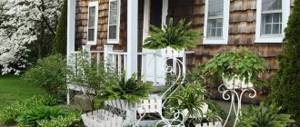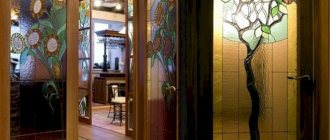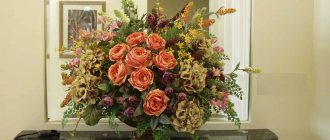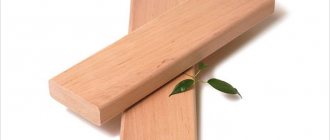One of the most common ways to decorate a garden plot is to decorate it beautifully with flowerpots and pots. Outdoor flowerpots can be of completely different shapes and materials, and their decor can successfully complement the garden composition.
How to choose the right flowerpots for your site?
Since flower pots on the street are designed to decorate the front area, courtyard, staircase, garden paths, seating areas, terrace or porch, they should be chosen based on functionality. A planted area with vegetation or a vacant lot will perfectly complement large flower beds or oblong flowerpots.
It is the dimensions of outdoor flowerpots that need to be taken into account when choosing such a decorative element. It all depends on the total area of the garden or plot. A flowerpot that is too large in a small area will look very intrusive and cumbersome, depriving the place of relaxation of such desired harmony and comfort. A small flowerpot on a long, luxurious garden alley, on the contrary, will get lost. But a pot of the right size will highlight and balance the space.
In the process of decorating a site, you should not get too carried away with bright and catchy decor. The design of flowerpots should not be more noticeable than the flower ensemble planted in it. Vases and pots in calm light shades of cream, white, terracotta, brown, and beige will look more elegant and harmonious in landscape design. If there is decor, it should be as laconic as possible and correspond to the overall stylistic idea of the landscape.
Types of outdoor flowerpots regarding material
An equally important part of choosing the right flowerpot is the material of manufacture. The most common are concrete, stone and plastic products. Clay is often used for flower pots. Its plasticity allows you to experiment with unique textures and shapes, but at the same time their surface must be covered with a special glaze to increase resistance to the lowest temperatures and retain moisture.
Flowerpots made of artificial or natural stone are usually placed on stone stands or cabinets and are often decorated with beautiful relief designs. Their main advantages are durability and eye-catching decorativeness. Such pots and flowerpots retain moisture well, which prevents the soil from drying out.
Concrete flowerpots are most often used to decorate large areas. This choice is due to the impressive size of the containers and their heavy weight.
They are made in the form of luxurious large vases. Such specimens look very aesthetically pleasing and noble, and compared to traditional flower beds, this is also a more practical way of planting plants.
Often, outdoor concrete flowerpots are presented in the form of modular containers, the design of which consists of a flower vase made of stone chips (or concrete) and a concrete base. Such products have a fairly long service life, are resistant to water and do not crack due to temperature changes. Also, outdoor flowerpots made of concrete are made using reinforcing mesh, which further enhances their strength.
The most economical option for decorating a garden plot is plastic flowerpots. They can often be seen in colorful rich colors, and in themselves they are a completely self-sufficient decorative product. The cost of such flowerpots is low. Definitely, the main advantage of plastic flower pots is mobility (due to their low weight).
And even those who prefer natural textures and materials purely from an aesthetic point of view can also choose a plastic flowerpot, because thanks to modern technologies, even plastic can imitate a variety of surfaces - stone, clay, etc.
Pots, flowerpots and vases made of plastic perfectly retain moisture, preventing flowers from drying out.
Concrete stands
For a large flowerpot you will need a plastic mold with a height of 50 cm and a diameter of 20 cm. The mixture is prepared from two parts of high-moor peat and one part of perlite. Measure the capacity using a 1.5 liter scoop. The mixture of three components is diluted with water until a thick consistency is obtained. The finished flowerpot will be heavy, so it should be made immediately in the place where it will stand in the future.
First, take a plastic pot that will act as a mold. The film is spread on the surface in an even layer. The cement mixture is placed on the bottom of the pot. It is important to maintain a layer thickness of no more than 4-5 centimeters. The thickness is measured with toothpicks or matches.
Begonia species with red, green and pink leaves
The strength of the product can be increased using a reinforcing structure. Shredded fiberglass can be added to the solution for durability.
There is also the option of making multi-colored flowerpots from this building material. To do this, the cement mortar is divided into parts, into which various special dyes are added. After this, multi-colored compositions are added at random, and the result is an original colorful stand.
After placing the mixture in molds, the entire structure is covered with film for 10 days. During this time, the structure will finally dry and take the correct shape without shrinkage. It is important to know that if it starts to dry out very quickly, it will need to be additionally moistened.
After 10 days, you need to check the structure by tapping the walls of the flowerpot. If the sound is dull, it means the structure is ready.
DIY outdoor flowerpot: interesting ideas in the photo
We advise creative, tireless craftsmen and experimenters to make an outdoor flowerpot with their own hands. Unique products can be created from wheelbarrows, old bicycles, wooden boxes, tubs, large dishes, barrels, baskets, etc. It is only important to follow the basic rule - coating surfaces with varnish or drying oil and treating flowerpots with antiseptics.
A real masterpiece can be created from clay. Both decorative white clay and natural clay are perfect for modeling. The first has a number of advantages - it is easy to decorate, hardens quickly, and can be sculpted without a workpiece. In addition, decorative clay does not require firing.
Before you start making an outdoor flowerpot, carefully consider its design. For decoration, you can use cute pebbles, pieces of mirrors, coins, beads, shells, fragments of ceramic tiles for mosaics, etc. All elements must be secured with construction glue or epoxy resin.
Wooden structures
To make a decorative stand from a stump, you need to find a suitable tree. This could be a small snag or the base of a tree, cut out with your own hands. The main thing is to select quality material.
You need to draw a circle on the stump. Then a cone-shaped drill is taken and an internal hole is cut out. In this case, it is important to adhere to the sequence: first, holes 10 cm deep are made throughout the entire stump, then all the insides are knocked out using a mechanical chisel, and at the end the surfaces are treated with a simple chisel.
Wooden flower vases are covered with stain from the inside. It is important to process all areas without leaving gaps. The finished flowerpots are attached to the treated and dried bottom. The inside parts of the circle are fastened using a construction stapler. Subsequent rows are attached so that the seams appear offset.
Finally, you need to place a pre-prepared container inside and plant your favorite flowers in it.
Choosing flowers for outdoor flowerpots
In addition to the flowerpots themselves, the flower arrangement planted in them plays a very important role. Flowers should be selected based on the location and size of the flowerpots. When composing a composition, you need to determine which element of the bouquet will occupy the central position. For outdoor flowerpots, plants with different colors and splendor of buds, height and type of stems are used. In large pots, two or three types of flowers look luxurious, with taller plants placed in the center, and shorter ones closer to the edges.
In oblong flowerpots, the area will be exquisitely decorated with climbing plants bordering the perimeter or circumference, or flowers beautifully falling to the ground. In flowerpots located near the wall, tall specimens are planted closer to the back panel, flowing or low ones - at the front edge.
Typically, plants in outdoor flowerpots are unpretentious and do not require particularly careful care. For full and beautiful flowering, it will be enough to loosen and water them in time. Only some species need to be fed with mineral fertilizers (solutions or granules).
Decoration options - the embodiment of any creative ideas
The simplest option for decorating a concrete vase is to treat the surface with a deep penetration primer and then coat it with acrylic-based paint. It is advisable to choose colors for outdoor flowerpots that are not very bright, so that they serve only as a frame for the plant.
Original options for decorating small architectural forms for flowers:
- Ornament painting;
- Carving hardening concrete using a knife or drill;
Idea: An extremely original result can be achieved by covering the product with a cloth soaked in cement mortar.
- Adding the required pigment to the concrete solution during pouring;
- Mosaic made of pebbles, shell rock, ceramic or colored glass fragments;
- The bas-relief is made by attaching large leaves to the inner surface of a large form before pouring, which are then removed with water;
- Decoration with jute rope.











